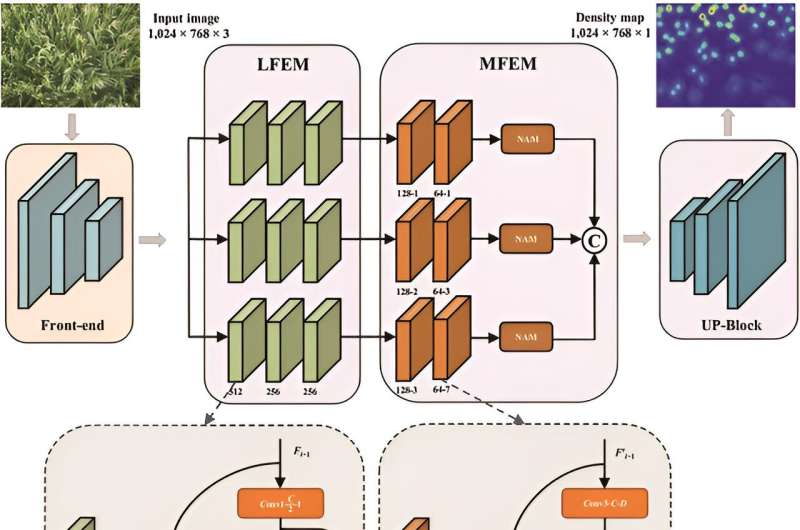This article has been reviewed according to Science X's editorial process and policies. Editors have highlighted the following attributes while ensuring the content's credibility:
fact-checked
proofread
Maize yield estimation: The MLAENet approach for accurate and efficient tassel counting

Maize is a vital global crop that requires accurate tassel counting for yield estimation and crop management, traditionally done manually or through basic imaging and machine learning techniques.
However, these methods falter due to environmental interference and the tedious nature of manual counting. Recent advances utilize deep-learning-based object detection, specifically deep convolutional neural networks (CNNs), to enhance accuracy and efficiency. Yet, these approaches struggle with the variable scale of maize tassels and complex backgrounds, leading to inefficient detection.
Current research explores density map estimation methods to overcome these limitations. These methods offer improved spatial distribution visualization and reduce manual labeling efforts. Nonetheless, the challenge remains to adapt these methods effectively for varied tassel sizes, intricate backgrounds, and the need for rapid yet accurate counting.
Plant Phenomics published a research article titled "A Multiscale Point-Supervised Network for Counting Maize Tassels in the Wild."
The study introduces a novel approach called Multiscale Lite Attention Enhancement Network (MLAENet) to count maize tassels using point-level annotations. This method encompasses a multicolumn lite feature extraction module utilizing multiple dilated convolutions for scale-dependent density map generation and a multi-feature enhancement module integrating an attention strategy for differentiating tassels from complex backgrounds.
Furthermore, an innovative up-sampling module known as UP-Block is designed to enhance the quality of density maps. The MLAENet's efficacy was validated on two public datasets, showing superior counting accuracy and inference speed over existing methods.
The experimental design involved a sophisticated software and hardware setup, including PyTorch, CUDA, and an NVIDIA GeForce RTX 3090Ti. Gaussian filtering was employed for density map generation, with propagation parameters adaptively determined based on maize tassel distances.
The model training adopted 5-fold cross-validation with a mix of training and validation sets, using pretrained VGG16 weights and Gaussian initialization. Adam optimizer was used for training with specific learning rates for each dataset.
Evaluation metrics like MAE, RMSE, R2, and SMAPE revealed MLAENet's high accuracy and robustness, particularly in scenarios with varying scales. Comparative analysis against state-of-the-art methods like MCNN, CSRNet, and MPS demonstrated MLAENet's superiority in both density map estimation and counting accuracy.
The model efficiently distinguished maize tassels from other plants, even under challenging conditions like large shooting distances or severe occlusions. Regarding inference speed, MLAENet significantly outperformed other networks, achieving an impressive speed of 32.90 FPS on standard-resolution images while maintaining high accuracy.
The model's design, including the LCB, ensures a balance between speed and accuracy, making it suitable for real-time applications. Ablation studies highlighted the importance of various components like NAM, UP-Block, and LCB in enhancing model performance.
In conclusion, MLAENet represents a breakthrough in maize tassel counting, providing high-quality density maps and robust performance across different scenarios. Future improvements may involve implementing advanced feature extraction methods to enhance network efficiency further.
More information: Haoyu Zheng et al, A Multiscale Point-Supervised Network for Counting Maize Tassels in the Wild, Plant Phenomics (2023). DOI: 10.34133/plantphenomics.0100
Provided by Plant Phenomics





















